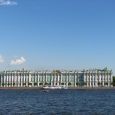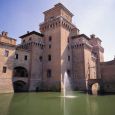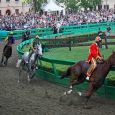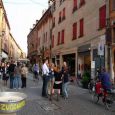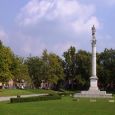Ferrara
Advertisement
By Air
The nearest major airport to Ferrara, Italy is Bologna Guglielmo Marconi Airport (BLQ / LIPE).This airport is in Bologna, Italy and is about 41 km from the center of Ferrara, Italy.If you're looking for international or domestic flights to BLQ, check the airlines that fly to BLQ.
By Train
Ferrara railway station, opened in 1862, forms part of the Padua–Bologna railway.It is also a terminus of three secondary railways, linking Modena with Ravenna and Rimini, Suzzara, and Codigoro, respectively.The station is located at Piazzale della Stazione, at the northwestern edge of the city centre.
By Bus
The bus station is on Via Rampari San Paolo.ACFT (0532 59 94 11) buses operate within the city and to surrounding towns such as Comacchio (1half hours, eight daily), as well as to the Adriatic beaches (note that some of these leave from the train station). The train is the better option for Bologna (30 minute, half-hourly) and Ravenna (1half hours, 17 daily).
Advertisement
Castle Estense
is a moated medieval structure in the center of Ferrara, northern Italy.It is a large block with four corner towers.On May 3, 1385, the Ferrarese people, driven to desperation by taxes and flooding that had brought ruin upon them, took themselves to the Marquis Niccolò II d'Este’s palace to ask the advice of Tommaso da Tortona, the high official held to be responsible for this grave situation. Nicolò tried to calm the revolt all day, but by the evening it was clear that the people's spirits were getting more and more angry and that the very safety of the Estensi was endangered.The order was therefore given to summon the disgraced Tommaso, who was given confession and communion and then given to the crowd, who literally tore him to pieces.In 1999 under the initiative of the provincial administration, it started "The Castle for the City" project, that scheduled a massive restoration of the castle. The itinerary of the restoration of the castle has gone through important steps to remember: the exhibition "The Triumph of Bacchus" inaugurated in 2002 by the President of the Italian Republic Carlo Azeglio Ciampi and the art exposition "The Este in Ferrara" opened on 14 March 2004 by the President of the European Commission Romano Prodi.
Diamond Palace
is a palace located on Corso Ercole I d'Este 21 in Ferrara, northern Italy.It is one of the most famous palaces in Italy, as well one of the most influential examples of European Renaissance architecture.Designed by Biagio Rossetti upon commission by Sigismondo d'Este, brother of Duke Ercole I, in 1492, it was built between 1493 and 1503.Used as a residential home by the Este and then, starting in 1641, by the Villa marquees, in 1832 the palace was acquired by the municipal in order to house the National Gallery of Art and the Civic University.From September 11, 2011 to January 8, 2012, Palazzo dei Diamanti will host "The Crazy Years" dedicated to the extraordinary artistic work that characterized Paris from the end of the Great War to the 1930s.There will be works by, among others, Monet, Matisse, Mondrian, Picasso, Braque, Modigliani, Chagall, Duchamp, De Chirico, Miro, Magritte and Dali.There will be paintings on display as well as sculptures, theatre costumes, photographs, ready made art, and sketches from the most important museums and private collections in the world.
Palazzo Schifanoia
is a Renaissance palace in Ferrara, Emilia-Romagna (Italy) built for the Este family.The name "Schifanoia" is thought to originate from "schivar la noia" meaning literally to "escape from boredom" which describes accurately the original intention of the palazzo and the other villas in close proximity where the Este court relaxed.The highlights of its decorations are the allegorical frescoes with details in tempera by or after Francesco del Cossa and Cosmè Tura, executed ca 1469–70, a unique survival of their time.alazzo Schifanoia forms part of the heritage of Ferrara conserved under the umbrella of the Musei Civici d'Arte Antica di Ferrara. The 14th and 15th century rooms contain collections of antiquities, a numismatic collection and medals cast by Pisanello and other Quattrocento artists to commemorate members of the Este family.
Communal Theatre
is an opera house, located in the Italian region of Emilia-Romagna, and built between 1786 and 1797.It used to seat 990.Privately-owned theatres with limited seating capacity had existed in the city for many years, but the arrival of Cardinal Spinelli, the new papal envoy, in 1786 spurred the construction of a new public theatre under the architects Cosimo Morelli and Antonio Foschini. However, their disagreements led to conflicting design concepts regarding the elliptical shape of the auditorium which were resolved through compromise.The theatre was finally ready for its inaugural presentation of Portogallo’s Gli Orazi e i Curiazi on 2 September 1798.The theatre is noted for staging the premiere of an early opera written by Gioacchino Rossini at the age of twenty, Ciro in Babilonia in March 1812.The present-day theatre auditorium has 5 tiers, while the ceiling displays four scenes from the life of Julius Caesar. It now seats 890.
University of Ferrara Botanic Garden
is a 4,500 square metre botanical garden operated by the University of Ferrara.It is located at Corso Porta Mare, 2b, I-44100 Ferrara, Emilia-Romagna, Italy, and is open weekday mornings.Admission is free.The university's garden was originally established in 1771 at a location on the via Paradiso, but in 1963 it was moved to its present location.It currently contains about 1300 species in its greenhouse (243 m2), and some 700 species outdoors.
Cathedral Museum
a few steps from the Cathedral of St. George.Collects some masterpieces from the cathedral itself.The museum was established in 1929 and recently reopened in new premises of the former church of San Romano (the classroom as well as the church is a fine cloister around which are arranged several rooms of the museum and the ticket office).In San Roman were once housed the monks Benedictines of Abbey Fruttuaria, before moving to the Canons Regular of St. Augustine .
Giovanni Boldini Museum
is in Palazzo Massari in Ferrara.Giovanni Boldini, Ferrara, was one of the best portrait painters of the nineteenth century European high society. He worked in Paris, in London and in Tuscany.The remarkable collection of his works, donated by the artist's widow, is placed in the halls of the main floor, along with many drawings, studies and personal belongings of the artist.The painter, though he had settled in Paris, was buried in his hometown at the Certosa cemetery.The tour starts from the baroque chapel of the palace, located beyond the Great Hall of Feasts.Then cross three small rooms with a painter's early works, including a portrait and oil Two white horses.
Ariostea Square
is an important square of Ferrara and an integral part of the third major addition that expanded the medieval city, this Herculean Addition, by the name of Ercole d'Este, Duke of Ferrara.Author of this development project was the architect Biagio Rossetti.The square, once called "New Square", extends along the decumanus addition of the great Renaissance, today Po-axis Port Sea Port. It has a rectangular shape with a low center ring made in 1933 for the races of the Palio. At the center of the square stands the column designed by the sixteenth-century Ferrara Ercole Grandi, commissioned by Duke Ercole for his equestrian statue.It was erected only in 1675 to house the statue of Pope Alexander VII, then that of Napoleon I and the 1833 statue of Ludovico Ariosto , a poet from which the square takes its name.Today the square is a meeting point for both locals facing it on the west side is the reminder that exerts its green space paved with the ring for a few minor sports events. On the last Sunday of May is also home to the Palio of Ferrara, established in 1279 and considered the oldest prize in the world.
August - December
January - May
Information not available
Advertisement

